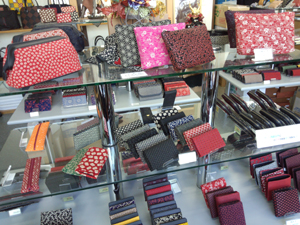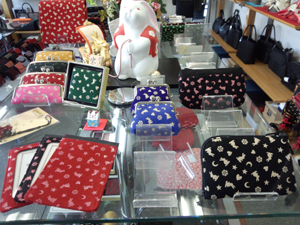Interviews & Reports
The Detailed Lacquered Deer Leather: Koshu-IndenTranslation: Marina Izumi, reviewed by Catherine Newman
Destination: "Inden-no-Yamamoto" in Kofu, Yamanashi Prefecture
Date of Visit: January 24, 2014
The city of Kofu flourished as the capital where the family of Takeda was based. Takeda was the warlord during the Sengoku period in the 15th century (also known as the Warring States period.) The name of Kofu was given by Nobutora Takeda, the father of Shingen Takeda, and designated Kofu as "the regional capital of Kai Province." A castle town was formed in Kofu as the base of Shingen during the Sengoku period, and Kofu went on to become prosperous in the early modern period as the center of business, as an important Western defense position for Edo and as a post-town along Koshu-Kaido which was a route connecting Edo and Kai Province.
"The Chronicles of Japan", the second oldest book of Japanese history, says that artifacts made with deer skin were brought to Japan around the end of the 5th century by leather craftsmen from Goryeo, one of the ancient Three Kingdoms of Korea. Today it is the oldest leather craft in Japan. It was not until the middle of the Edo period that Inden came to be made in its modern way by drawing designs on deer leather using lacquer. Even so, deer leather crafts saw great advancements in the time of the development of samurai society and amidst war disturbances, since the supple and light but sturdy characteristics of deer skin were valued as a material suitable for armor and harnesses. Today, we can still see a bag called "Shingen-bukuro" (Shingen bag). One theory states that the name originates from the bag made of deer leather that samurai generals used to hold their armor.
In this interview, we heard from Yusuke Yamamoto, who inherits the traditional skills from his father Makoto Yamamoto, the only METI*-designated traditional craftsperson of Koshu-Inden. (*METI = Ministry of Economy, Trade and Industry)

From bags to small articles, products in a variety of colors which is exceptional for Inden, are displayed in the shop.
―What kind of craft is Inden?
Yamamoto: Texts in the 700's refer to crafts made by putting a paper pattern on deerskin and smoking it to draw the design. Therefore, it seems that crafts using deer leather had already been created by that time. It is said that the present technique of drawing delicate designs with lacquer on dyed deer leather dates back to the Edo era.
The name "Inden" originates from its Indian style designs. During the Edo period, Japan was in a state of isolation and all imported articles were presented to the shogunate (bakufu) and came through Nagasaki, the window to foreign countries. There were Indian silk textiles among those articles. Inspired by their extremely beautiful designs, people started to create something similar using domestic materials and techniques. When drawing the designs of Inden, we put lacquer on Ise-katagami, which is the Japanese craft of making paper stencils for dying textiles.The Ise-katagami is then placed on the deer leather. Ise-katagami is also used in creating Edo-komon, a type of Japanese kimono.

Series of colorful rabbit-patterned products
―When crafting Inden today, the skins of deer inhabiting Southern China or Taiwan are used. What is the reason for this?
Yamamoto: This is because we can get stable supplies of high quality leather. Wild deer are sometimes targeted for extermination these days in Japan due to their increase in number, but we still have only less than a three-digit number of deer yearly in this prefecture. It was after the Showa period that deer skins started to be imported from China. They were popularly put into use as Chinese deer skins turned out to be dyed well. Indeed, the raw skins as well as the lacquer are imported from overseas, but the whole manufacturing process starting from tanning the deer skins takes place in Japan.
―(Touching the case of a fan) It feels very light and pliant.
Yamamoto: Deer leather is originally soft, but it becomes hard if we simplify the process of tanning. Here (at Yamamoto's Inden workshop), we tan deer skins with a process that preserves their original softness. That's why it is characterized by it's soft but thick and sturdy touch.
―The paper pattern, Ise-katagami, used for drawing the design is all hand-carved, isn't it?
Yamamoto: 90 percent of the paper patterns we use here are hand-carved. As for the OEM products, we sometimes use patterns carved by lazer to save costs.
―We heard that your father is the only METI-designated traditional craftsperson of Koshu-Inden. Are you going to obtain a qualification as well?
Yamamoto: Yes, I'm thinking of that. In my case, I started to be engaged in sales at the age of 18, and in production at 21. Since I am 32 now, I meet the requirements for the qualification if my experience in sales is taken into account. It is true that 13 years of practical experience seems to be a tough requirement. However, at the same time it seems reasonable considering the purpose is to instruct the next generation. Here, the whole process including cutting the deer leather, drawing the designs, sewing the products and sales are all done by our family members. If the process of production is separated, the inheritance of the techniques could be difficult.
―There are only 4 companies that produce Koshu-Inden today, which seems a small number. Do you have any plans for the future concerning the inheritance of the skills?
Yamamoto: The production of Inden requires a huge amount of money as an initial investment in order to purchase tools and various kinds of paper patterns or materials. One idea would be to support the independence of craftsmen by lending them the necessary tools and so on if there were enough space in our workshop. Still, it is not so easy at this point in time.
―At department stores, Inden products are often sold as traditional crafts, not as fashion items. What do you think about this?
Yamamoto: I do not think it necessary to turn away from it's history as a traditional technique passed down for several hundreds of years. However, when it comes to sales, we need to think in a liberal way.
After the visit
At the store where we conducted this interview, colorful, chic products that could update the image of Inden were displayed. We sensed their constant efforts aimed at new possibilities while preserving its traditional techniques.
Recently, Yamamoto's Inden products have begun to be sold at a museum shop in Britain.
This reminded us of people's strong interests in the Inden products seen at the Japan Expo in Paris which we attended. We would like to continue our activities in order to raise awareness of the charm of Inden in as many people as possible, not to mention in Japan as well as overseas.




